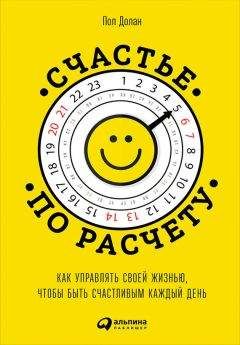Пол Долан - Счастье по расчету. Как управлять своей жизнью, чтобы быть счастливым каждый день

Помощь проекту
Счастье по расчету. Как управлять своей жизнью, чтобы быть счастливым каждый день читать книгу онлайн
215
Hackman J.R., Oldham G.R. Motivation through the design of work: test of a theory. Organizational Behavior and Human Performance 1976; 16: 250–79.
216
Daugherty J.R., Brase G.L. Taking time to be healthy: predicting health behaviors with delay discounting and time perspective. Personality and Individual Differences 2010; 48: 202–7.
217
Goodin R.E., Rice J.M., Parpo A., Eriksson L. Discretionary time: a new measure of freedom. Cambridge University Press, 2008.
218
Wang M., Sunny Wong M.C. Leisure and happiness in the United States: evidence from survey data. Applied Economics Letters 2011; 18: 1813–16.
219
Geiselman R.E. Enhancement of eyewitness memory: an empirical evaluation of the cognitive interview. Journal of Police Science & Administration 1984.
220
Гилберт Д. Спотыкаясь о счастье. – М.: Альпина Паблишер, 2015.
221
Gilbert D., Killingsworth M.A., Eyre R.N., Wilson T.D. The surprising power of neighborly advice. Science 2009; 323: 1617–19.
222
Dobewall H., Realo A., Allik J., Esko T., Metspalu A. Self-other agreement in happiness and life-satisfaction: the role of personality traits. Social Indicators Research 2013; 114: 479–92.
223
Lyubomirsky S., Lepper H. A measure of subjective happiness: preliminary reliability and construct validation. Social Indicators Research 1999; 46: 137–55.
224
Roberts J., Hodgson R., Dolan P. “It’s driving her mad”: gender differences in the effects of commuting on psychological health. Journal of Health Economics 2011; 30: 1064–76.
225
Seidlitz L., Diener E. Sex differences in the recall of affective experiences. Journal of Personality and Social Psychology 1998; 74: 262–71.
226
Шварц Б. Парадокс выбора. Почему «больше» значит «меньше». – М.: Добрая книга, 2005.
227
Bisson J.I., Jenkins P.L., Alexander J., Bannister C. Randomised controlled trial of psychological debriefing for victims of acute burn trauma. British Journal of Psychiatry 1997; 171: 78–81.
228
Bonanno G.A. Loss, trauma, and human resilience: have we underestimated the human capacity to thrive after extremely aversive events? American Psychologist 2004; 59: 20.
229
Rule N.O., Ambady N. Brief exposures: male sexual orientation is accurately perceived at 50ms. Journal of Experimental Social Psychology 2008; 44: 1100–1105.
230
Dijksterhuis A., van Olden Z. On the benefits of thinking unconsciously: unconscious thought can increase post-Choice satisfaction. Journal of Experimental Social Psychology 2006; 42: 627–31.
231
Creswell J.D., Bursley J.K., Satpute A.B. Neural reactivation links unconscious thought to decision-making performance. Social Cognitive and Affective Neuroscience 2013.
232
Payne J.W., Samper A., Bettman J.R., Luce M.F. Boundary conditions on unconscious thought in complex decision-making. Psychological Science 2008; 19: 1118–23.
233
Newell B.R., Wong K.Y., Cheung J.C., Rakow T. Think, blink or sleep on it? The impact of modes of thought on complex decision-making. Quarterly Journal of Experimental Psychology 2009; 62: 707–32; Dijksterhuis A., Van Baaren R.B., Bongers K.C., Bos M.W., Van Leeuwen M.L., Van der Leij A. The rational unconscious: conscious versus unconscious thought in complex consumer choice. Social Psychology of Consumer Behavior 2009: 89–108.
234
Hsee C.K., Zhang J., Yu F., Xi Y. Lay rationalism and inconsistency between predicted experience and decision. Journal of Behavioral Decision Making 2003; 16: 257–72.
235
Thaler R.H., Sunstein C.R. Nudge: improving decisions about health, wealth, and happiness. Yale University Press, 2008.
236
Leventhal H., Singer R., Jones S. Effects of fear and specificity of recommendation upon attitudes and behavior. Journal of Personality and Social Psychology 1965; 2: 20; Zhao M, Lee L, Soman D. Crossing the virtual boundary: the effect of task-irrelevant environmental cues on task implementation. Psychological Science 2012; 23: 1200–1207.
237
Dolan P., Hallsworth M., Halpern D., King D., Metcalfe R., Vlaev I. Influencing behaviour: the MINDSPACE way. Journal of Economic Psychology 2012; 33: 264–77; Dolan P., Hallsworth M., Halpern D., King D., Vlaev I. MINDSPACE: influencing behaviour through public policy. Report for the Cabinet Office, 2010.
238
Beshears J., Choi J.J., Laibson D., Madrian B.C. Social security policy in a changing environment. In: The importance of default options for retirement saving outcomes: evidence from the United States. University of Chicago Press, 2009: 167–69; Rithalia A., McDaid C., Suekarran S., Myers L., Sowden A. Impact of presumed consent for organ donation on donation rates: a systematic review. British Medical Journal 2009; 338.
239
Team B.I. Applying behavioral insights to reduce fraud, error and debt. UK London Cabinet Office, 2012.
240
Dolan P., Metcalfe R. Better neighbors and basic knowledge: a field experiment on the role of non-pecuniary incentives on energy consumption. Unpublished working paper, 2013.
241
Holland R.W., Hendriks M., Aarts H. Smells like clean spirit: nonconscious effects of scent on cognition and behavior. Psychological Science 2005; 16: 689–93.
242
Birnbach D., King D., Vlaev I., Rosen L., Harvey P. Impact of environmental olfactory cues on hand hygiene behaviour in a simulated hospital environment: a randomized study. Journal of Hospital Infection 2013.
243
Shirtcliff E.A., Allison A.L., Armstrong J.M., Slattery M.J., Kalin N.H., Essex M.J. Longitudinal stability and developmental properties of salivary cortisol levels and circadian rhythms from childhood to adolescence. Developmental Psychobiology 2012; 54: 493–502.
244
Holzman D.C. What’s in a color? The unique human health effects of blue light. Environmental Health Perspectives 2010; 118: A22–A27.
245
Moore E. A prison environment’s effect on health care service demands. Journal of Environmental Systems 1981; 11: 17–34; Ulrich R. View through a window may influence recovery from surgery. Science 1984; 224: 420–21.
246
Park S.H., Mattson R.H., Kim E. Pain tolerance effects of ornamental plants in a simulated hospital patient room. In: Relf D., ed. XXVI International Horticultural Congress: Expanding Roles for Horticulture in Improving Human Well-Being and Life Quality 639, 2002: 241–47; Katcher A., Segal H., Beck A. Comparison of contemplation and hypnosis for the reduction of anxiety and discomfort during dental surgery. American Journal of Clinical Hypnosis 1984; 27: 14–21.
247
Wansink B. Mindless eating: why we eat more than we think. Random House, 2010.
248
Wansink B., Sobal J. Mindless eating: the 200 daily food decisions we overlook. Environment and Behavior 2007; 39: 106–23.
249
Wansink B. Super bowls: serving bowl size and food consumption. Journal of the American Medical Association 2005; 293: 1723–28.
250
Chiou W., Yang C., Wan C. Ironic effects of dietary supplementation illusory invulnerability created by taking dietary supplements licenses health-risk behaviors. Psychological Science 2011; 22: 1081–86.
251
Kaptchuk T.J., Friedlander E., Kelley J.M., et al. Placebos without deception: a randomized controlled trial in irritable bowel syndrome. PLoS ONE 2010; 5: e15591.
252
Plassmann H., Mazar N., Robitaille N., Linder A. The origin of the pain of paying. Advances in Consumer Research 2011; 39: 146.
253
Werner C.M., Turner J., Shipman K., et al. Commitment, behavior, and attitude change: an analysis of voluntary recycling. Journal of Environmental Psychology 1995; 15: 197–208.
254
Turner-McGrievy G., Tate D. Weight loss social support in 140 characters or less: use of an online social network in a remotely delivered weight loss intervention. Translational Behavioral Medicine: Practice, Policy, Research 2013: 1–8.
255
Ryan R.M. Further examining the American dream: differential correlates of intrinsic and extrinsic goals. Personality and Social Psychology Bulletin 1996; 22: 280–87.
256
Koo M., Fishbach A. The small-area hypothesis: effects of progress monitoring on goal adherence. Journal of Consumer Research 2012; 39: 493–509.
257
Giné X., Karlan D., Zinman J. Put your money where your butt is: a commitment contract for smoking cessation. American Economic Journal: Applied Economics 2010; 2: 213–35.
258
Dunn E., Norton M. Happy money: the science of smarter spending. Simon & Schuster, 2013.
259
Thaler R. Toward a positive theory of consumer choice. Journal of Economic Behavior & Organization 1980; 1: 39–60.
260
De La Ronde C., Swann W.B. Partner verification: restoring shattered images of our intimates. Journal of Personality and Social Psychology 1998; 75: 374.
261
Шуровьески Дж. Мудрость толпы. Почему вместе мы умнее, чем поодиночке, и как коллективный разум влияет на бизнес, экономику, общество и государство. – Манн, Иванов и Фербер, 2014.
262
Bargh J.A., Williams E.L. The automaticity of social life. Current Directions in Psychological Science 2006; 15: 1–4.
263
Dimberg U., Thunberg M. Unconscious facial reactions to emotional facial expressions. Psychological Science 2000; 11: 86.
264
Parkinson B., Simons G. Affecting others: social appraisal and emotion contagion in everyday decision making. Personality and Social Psychology Bulletin 2009; 35: 1071–84.
265
Totterdell P. Catching moods and hitting runs: mood linkage and subjective performance in professional sport teams. Journal of Applied Psychology 2000; 85: 848.
266
McIntosh D.N. Spontaneous facial mimicry, liking and emotional contagion. Polish Psychological Bulletin 2006; 37: 31.
267
Larson R.W., Richards M.H. Family emotions: do young adolescents and their parents experience the same states? Journal of Research on Adolescence 1994; 4: 567–83.
268
Putnam R.D. Bowling alone: the collapse and revival of American community. Simon & Schuster, 2001.
269
Luttmer E. Neighbors as negatives: relative earnings and well-being. Quarterly Journal of Economics 2005; 120: 963–1002.
270
Card D., Mas A., Moretti E., Saez E. Inequality at work: the effect of peer salaries on job satisfaction. American Economic Review 2012; 102: 2981–3003.
























